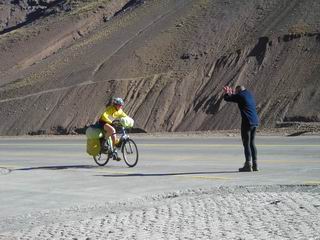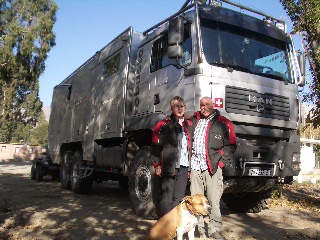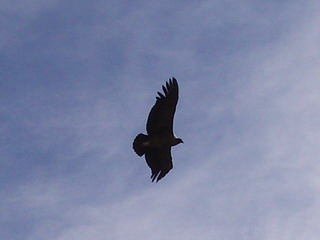|
|
|
|
April 28 – June 4, 2006 Santiago – Los Andes (Chile) – Puente del Inca – Mendoza – San Juan – Valle de la Luna – Talampaya – Chilecito – Belen – Cafayate - Salta (Argentina) |
|
|
|
|
|
The highway out of Santiago to the Andes was surprisingly and pleasantly stress free. Los Andes town is the gateway to the Cordillera and on day three from Santiago we hit the famous caracoles hairpin bends. 33 spectacular curves carved into the side of a steep valley was part of our route up to the international Cristo Redentor tunnel at 3185m above sea level (our highest so far). |
|
|
|
 |
| Los caracoles bends |
Almost there... |
|
|
|
| On this stretch we enjoyed the company of young Juan Andrés from Colombia, travelling solo from down south back home. |
|
|
|
|
|
Mendoza province |
Emerging from the tunnel, the valley looked more spacious and the rocks were a blaze of reds, yellows and greens, as opposed to grey on the Chilean side. We even had the bonus of seeing Aconcagua in the evening sun. This is the highest mountain of the Americas and stands at 6960m |
|
|
|
|
The spa hotel at Puenta del Inca was victim of an avalanche some years ago. Around the ruins, time has left its mark, with layers of colourful mineral deposits making it an unusual photo stop in this Wild West scenery. |
|
|
Road to Uspallata |
From Puente del Inca it was a long, steady breeze (with headwind) down to Uspallata through bleak, vast and colourful mountain terrain. Incidentally, this is where “Seven Years in Tibet” was filmed and so today there’s still a constant trickle of fans trying to retrace Brad Pitt’s steps in these unique surrounds, resembling the rooftop of the world. |
|
After three days of this gorgeous terrain, the landscape opened up and gave way to the vineyards of Mendoza, prized as one of Argentina’s best wines. What makes Mendoza city such a pleasant hub are the tree-lined boulevards, wide pedestrian sidewalks and numerous shady plazas. |
|
|
Fancy a melon? |
Heading north from here we entered the province of San Juan, where vineyards, melons, pumpkins, olives and almonds are the life-force in the few places where water is available. Here a huge melon costs 0.12 euros, while the locals earn 5 euros a day for 12 hours hard labour out in the fields. Summer temperatures reach 50 degrees Celsius, so we were quite happy to cruise along in the cooler 25 degrees of autumn days. |
|
The further north we headed, the dryer and more desert like the land became. It’s no wonder that this was the venue for the Difunta Correa story. Right through Argentina, even as far south as Tierra del Fuego, we’ve been passing by unusual roadside shrines of pet bottles filled with water. |
|
|
|
These are commemorating a saint-like figure from these parts. In the late 1800s, a Señora Correa died of thirst out here, while the milk of her breast sustained the life of her suckling child for another 3 days. This miracle has touched the hearts of Argentines high and low and their faith in her is reflected in the countless shrines along the roads. |
|
Leaving a pet bottle at a Difunta Correa shrine would be equivalent to lighting a candle in a catholic church. The main shrine in Vallecito is visited by some 70,000 pilgrims every year, who leave everything from photos, plaques, sports trophies, wedding dresses, car registration plates, miniature houses and model trucks in gratitude for favours received. |
|
|
Gauchito Gill shrine |
While on the theme of roadside shrines, another miracle worker, Gauchito Gil, is just as often venerated. A robin-hood character from the same era, grants Argentine truckers the right to speed like lunatics. A quick stop to leave some red ribbon at his shrine, their reckless driving is quickly forgiven and the open road becomes their playground once again. |
|
This whole region of northern San Juan is quite poor. Water is very scarce and many villages reflect the severe subsistence living the locals endure. Goats run wild in the desert, scavenging what they may and are used as barter for whatever the villagers need. |
|
| A little better off are the policemen on the road checkpoints in this never-never land. | |
|
|
For their 3-day desert duty/3 day off schedule they bring home a mere 250 euros a month. This 1000 peso salary was worth 1000 US dollars in 2001, so with the sudden devaluation of the peso, many Argentines are now feeling the pinch. However, the cops were happy to load us with a few days supply of fruit that they received as tokens from the truckers whose cargos they were meant to control! |
|
|
|
| I've been to the desert... |
... a horse with no name... |
|
The main attraction of San Juan is Valle de la Luna. This Valley of the Moon is an extensive national park where the forces of erosion continue to leave a beautiful trail of destruction in rock forms resembling mushrooms, submarines, bowling balls and the like. |
|
|
|
|
|
The Painted Valley, Valle de la Luna |
The painted valley is made up of layers of red, green, white and grey sandstone, carved into an undulating moonscape by no less then 250 million years of wind. |
| The local university has a right paradise here unearthing dinosaur fossils from the Triassic era and all the -ology students you can think of contribute to a very impressive and informative museum in the park. |
|
 Talampaya National Park |
Just across the border in La Rioja province is the breathtaking Talampaya National Park. Here we cycled on a dry river bed through a 200m deep gorge of sheer red sandstone walls, on the lines of Australia’s red centre. What a perfect example of the forces of erosion. This time water was the protagonist. |
|
As amazing as these two national parks were, there was more to come. This time a mountain pass called Cuesta de Miranda, that led through a whole lot more red rocks of every conceivable shape and size, gorgeous cliff side roads hanging on for dear life, with fabulous views of snowy mountains, a deep gorge and the autumn colours down in the vineyards of Sañogasta. |
|
|
|
|
|
Fede and Kurt |
Fede, a professional basketball player for the local club was our host in Chilecito. He took to the bike and showed us round the highlights of this historical town. |
|
Chilecito grew around two goldmines. The fascinating project of constructing a 35km cable car line from one of the mines at 4600m to town was completed by a German contractor in the early 1900s. |
Cable car station, Chilecito |
|
Colourful streams, Chilecito |
Although the mines were closed in 1948, they still contain deposits of gold, silver, copper, iron and mercury to name but a few. Different rivers run down the mountain with the colours of the mineral they wash out, creating a trail of yellows, greens, blues, whites, and browns in the trickling streams. |
|
We hiked up to and camped at the cable car station number 5 at 2600m. Never before had we seen so many condors at such close range – all of which seem to have a happy life feeding on the feral cows and calves that fall trapped in the steep ravines of this inhospitable mountain range. |
|
|
Dream campsite |
This past month we have had some of the most amazing wild campsites. Among the cacti, the red rocks and on dry river beds we were well out of sight and could enjoy campfires without nosey onlookers or neighbours. |
|
Daylight these days is between 8am and 7pm. Generally we are on the bikes by 9.30am wrapped up in gloves and headbands for a chilly start. By midday, temperatures are up in the mid twenties, which make for very pleasant cycling. Nights vary depending on altitude and wind. Temperatures drop with the sun and on our coldest night of late we even had ice inside the tent the next morning. |
|
|
|
|
| Clay oven in garden, Santa María |
Church, Campanas |
| In Belen, Darina had her arm grabbed by a big burly 2m bloke with a ball of coca leaves in his right cheek. (Coca leaves are the raw material for cocaine). | |
|
Before she knew it, she was in the centre of a circle of six men; two dressed in black bomber jackets, with loud walkie- talkies at hand. The interrogation that followed soon turned tension into laughter as their identity was revealed. Local radio strikes again! Even Kurt was forced to contribute to the local entertainment! |
|
|
Tuathal, from Dublin |
Northern Argentina has been quite the bottleneck for touring cyclists these past few weeks, now that the cycling season in Patagonia is pretty much over. We’ve met British, Swiss, German, French, Uruguayan and Colombian cyclists. In addition, Darina was happy to finally discover that she’s not the only Paddy on the bike!
|
|
Another friendly couple we’ve bumped into repeatedly in this area is traveling somewhat differently. Brigitte, Edy and Amigo have turned their dream into reality with their 20-tonne Action Mobile, which certainly gives them a bird’s eye view of this magnificent landscape. It was delightful to be wined and dined in the comfort of their cozy home, while discussing the merits of early retirement. |
 |
|
|
|
|
Llamas and goats in the altiplano, Santa María |
|
|
Pachamama museum |
Indigenous culture is quite apparent in these parts. Amaicha del Valle, a village that boasts 365 days of sunshine a year, is home to a wonderful museum. The Pachamama museum is a very elaborate and artistic homage to the Goddess of Mother Earth. This brainchild of artist Hector Cruz is reminiscent of the Palais Idéal du Facteur Chéval and Nek Chand´s Rock Garden in Chandigarh, India. |
|
The reconstructed ruins of Quilmes is another Hector Cruz project. This settlement of a few thousand people flourished from the 11th to the 15th centuries. Afterwards, the successive invasions of Incas and Spaniards managed to completely wipe out the town, leaving nothing but stone rubble and cacti. A harsh reminder of colonial times.
|
|
|
|
In Cafayate, Kurt indulged in some of the best Argentine Malbec red wines, while Darina was content with the beautiful autumn colours of the local vineyards. What we both enjoyed was the company of fellow cyclists and travellers in this quaint, colonial town. |
|
|
|
|
Scenes from Cafayate |
|
| The riot of colour was still not over. 20km outside Cafayate, on the Ruta 68, yet another gorge began. A magnificent 60km of colours and mad rock formations, including a natural amphitheatre, led us along the river to Alemania. |
|
|
|
|
|
|
|
|
Quebrada de Cafayate, Ruta 68 |
|
|
|
|
|
Tobacco harvest out to dry |
Then, the reds, browns, yellows and creams turned to a lush, vibrant green. Tobacco, corn, wheat, olives, quinoa, tiny sunflowers and peppers were a stark contrast to our desert reds of this past month. Palm and banana trees and red poinsetta flowers all the way to Salta reminded us of the tropics and we had our first shower of rain in 6 weeks. |
| This has been one of the most amazing stages of our trip so far. It’s going to be hard to beat! | |


